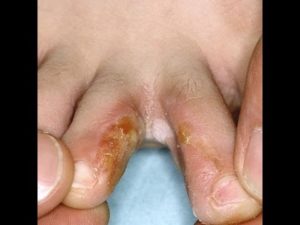Athlete’s Foot: Athlete’s foot, also known as tinea pedis, is a frequent skin infection of the feet caused by the fungus, that usually appears between the toes.Signs and symptoms often include itching, scaling, and redness. The next most common area is the bottom of the foot. The same fungus may also affect the nails or the hands. It is a member of the group of diseases known as tinea.

Causes & Risk for Athlete’s Foot
Athlete’s foot happens when the tinea fungus grows on the feet. You can develop the fungus through direct contact with an infected person, or by touching surfaces contaminated with the fungus. The fungus grows in warm, moist environments. It’s commonly found in showers, on locker room floors, and around swimming pools.

Several behaviors increase your risk. Factors that enhance the risk of getting athlete’s foot include:
- Keeping your feet wet for long periods of time
- Having sweaty feet
- Sharing socks, shoes, or towels with an infected person
- Wearing tight-fitting, closed-toe shoes
- Having a minor skin or nail injury on your foot
Signs and Symptoms of Athlete’s Foot
Athlete’s foot usually strikes the skin between the toes or on the bottom of the feet.
Many people with athlete’s foot become no symptoms at all and do not also know they have an infection. Common manifestations of athlete’s foot typically carry various degrees of itching, stinging, and burning. The skin may constantly peel, and in especially severe cases, there may be remarkable cracking, fissuring, pain, and itching in the toe webs. Infrequently, athlete’s foot can blister.
Diagnosis of Athlete’s Foot
A physician may diagnose athlete’s foot by the signs & symptom or a physician may require a skin test if they aren’t sure a fungal infection is generating your symptoms.
A skin sore potassium hydroxide (KOH) exam is the usual common test for athlete’s foot. A physician scrapes off a small area of infected skin and places it within potassium hydroxide (KOH). The KOH damages normal cells and leaves the fungal cells intact so they are easy to see supporting a microscope.
Treatment of Athlete’s Foot
It can ordinarily be treated using antifungal treatments available from pharmacies without needing to see physicians.
Antifungal medications work by stopping the fungus causing your athlete’s foot from spreading. They become in creams, sprays, liquids, and powders, and are used in a subsequent way:
OTC medications
There are many OTC topical antifungal medications, including:
- Terbinafine (Lamisil AT)
- Miconazole (Desenex)
- Clotrimazole (Lotrimin AF)
- Tolnaftate (Tinactin)
- Butenafine (Lotrimin Ultra)
Prescription medications
Some medications your physician may prescribe for athlete’s foot include:
- Oral antifungal medications such as fluconazole (Diflucan), itraconazole (Sporanox), or prescription-strength terbinafine (Lamisil)
- Topical, prescription-strength clotrimazole or miconazole
- Topical steroid medicines to reduce painful inflammation
- Oral antibiotics if bacterial germs develop due to raw skin and blisters

Home Remedies
Your specialist may suggest that you immerse your feet in the salt water or diluted vinegar to help dry up blisters.
Alternative therapy
Tea tree oil has been utilized as an alternative therapy for treating athlete’s foot with some progress. A scientific study declared in the August 2002 issue of the Australian Journal of Dermatology announced that a 50 percent solution of tea tree oil efficiently treated athlete’s foot in 64 percent of trial participants.
Preventing of Athlete’s Foot
You can diminish your risk of contracting athlete’s foot by:
- Drying your feet gently but thoroughly after washing them, particularly the areas between your toes
- Wearing cotton socks and wear a fresh pair of socks, tights or stockings every day
- Change your shoes each couple of days – this provides them to dry out between uses
- Not walking throughout barefoot in public showers and locker rooms
- Not receiving towels, socks, and shoes with other people, and assuring your towels are soaked regularly
- Not practicing moisturizer inside your toes, as this can help fungi multiply
- Applying talcum powder on your feet to stop them getting sweaty

